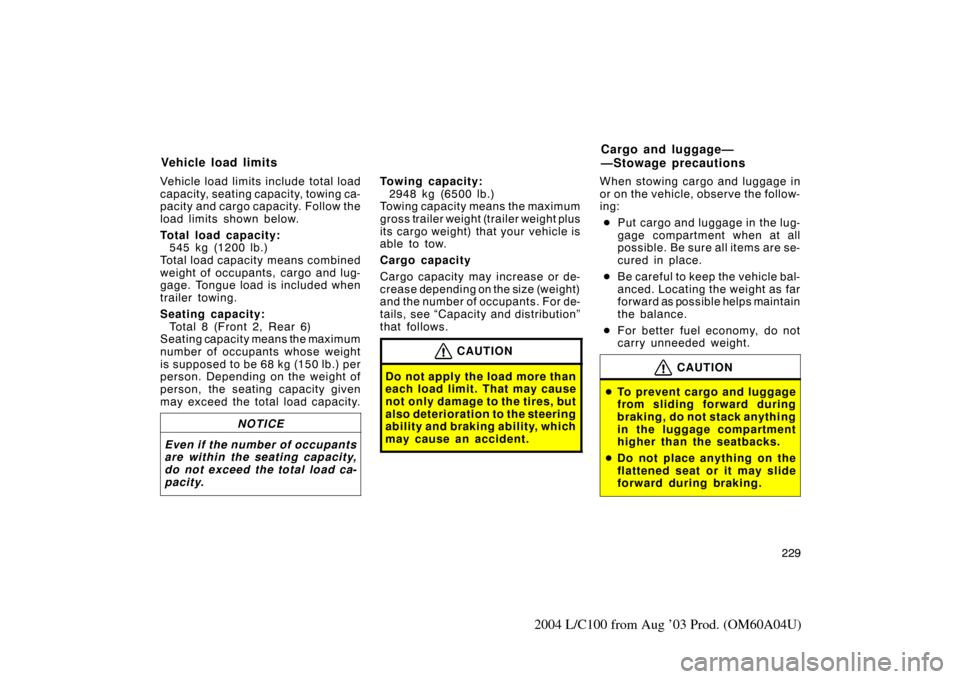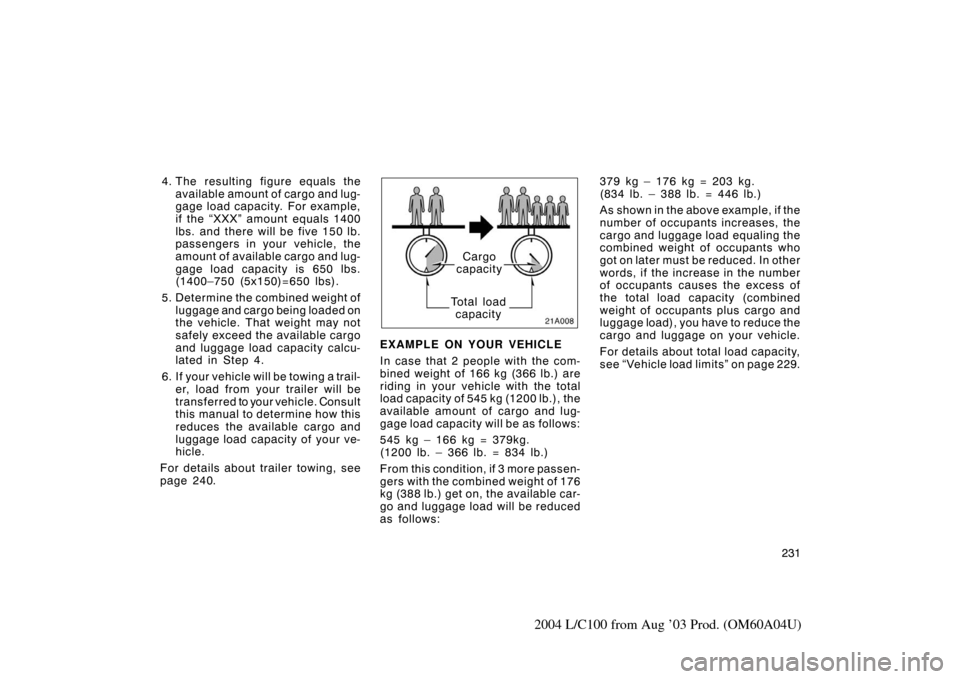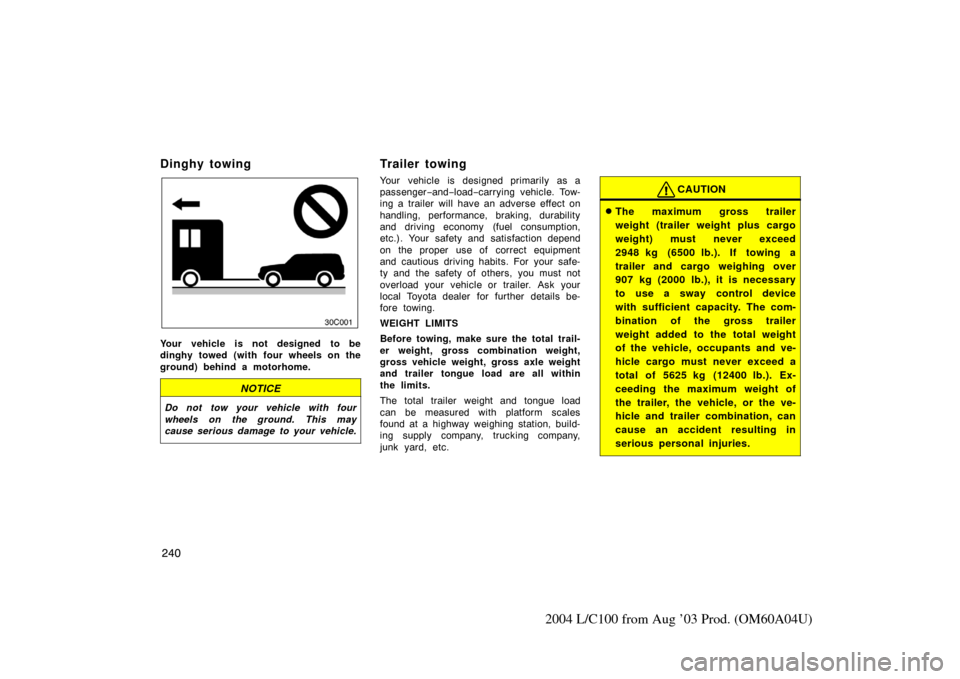Page 237 of 342

229
2004 L/C100 from Aug ’03 Prod. (OM60A04U)
Vehicle load limits include total load
capacity, seating capacity, towing ca-
pacity and cargo capacity. Follow the
load limits shown below.
Total load capacity:
545 kg (1200 lb.)
Total load capacity means combined
weight of occupants, cargo and lug-
gage. Tongue load is included when
trailer towing.
Seating capacity: Total 8 (Front 2, Rear 6)
Seating capacity means the maximum
number of occupants whose weight
is supposed to be 68 kg (150 lb.) per
person. Depending on the weight of
person, the seating capacity given
may exceed the total load capacity.
NOTICE
Even if the number of occupants
are within the seating capacity,
do not exceed the total load ca-
pacity.
Towing capacity: 2948 kg (6500 lb.)
Towing capacity means the maximum
gross trailer weight (trailer weight plus
its cargo weight) that your vehicle is
able to tow.
Cargo capacity
Cargo capacity may increase or de-
crease depending on the size (weight)
and the number of occupants. For de-
tails, see “Capacity and distribution”
that follows.
CAUTION
Do not apply the load more than
each load limit. That may cause
not only damage to the tires, but
also deterioration to the steering
ability and braking ability, which
may cause an accident.
When stowing cargo and luggage in
or on the vehicle, observe the follow-
ing:
� Put cargo and luggage in the lug-
gage compartment when at all
possible. Be sure all items are se-
cured in place.
� Be careful to keep the vehicle bal-
anced. Locating the weight as far
forward as possible helps maintain
the balance.
� For better fuel economy, do not
carry unneeded weight.
CAUTION
�To prevent cargo and l uggage
from sliding forward during
braking, do not stack anything
in the luggage compartment
higher than the seatbacks.
� Do not place anything on the
flattened seat or it may slide
forward during braking.
Veh icle lo ad limit s Cargo and luggage—
—Stowage precautions
Page 239 of 342

231
2004 L/C100 from Aug ’03 Prod. (OM60A04U)
4. The resulting figure equals theavailable amount of cargo and lug-
gage load capacity. For example,
if the “XXX” am ount equals 1400
lbs. and there will be five 150 lb.
passengers in your vehicle, the
amount of available cargo and lug-
gage load capacity is 650 lbs.
(1400–750 (5x150)=650 lbs).
5. Determine the combined weight of luggage and cargo being loaded on
the vehicle. That weight may not
safely exceed the available cargo
and luggage load capacity calcu-
lated in Step 4.
6. If your vehicle will be towing a trail- er, load from your trailer will be
transferred to your vehicle. Consult
this manual to determine how this
reduces the available cargo and
luggage load capacity of your ve-
hicle.
For details about trailer towing, see
page 240.
Total load capacity Cargo
capacity
EXAMPLE ON YOUR VEHICLE
In case that 2 people with the com-
bined weight of 166 kg (366 lb.) are
riding in your vehicle with the total
load capacity of 545 kg (1200 lb.), the
available amount of cargo and lug-
gage load capacity will be as follows:
545 kg – 166 kg = 379kg.
(1200 lb. – 366 lb. = 834 lb.)
From this condition, if 3 more passen-
gers with the combined weight of 176
kg (388 lb.) get on , the av ailable car-
go and luggage load will be reduced
as follows: 379 kg – 176 kg = 203 kg.
( 834 lb. – 388 lb. = 446 lb. )
As shown in the above example, if the
number of occupants increases, the
cargo and luggage load equaling the
combined weight of occupants who
got on later must be reduced. In other
words, if the incr
ease in the number
of occupants causes the excess of
the total load capacity (combined
weight of occupants plus cargo and
luggage load), you have to reduce the
cargo and luggage on your vehicle.
For details about total load capacity,
see “Vehicle load limits” on page 229.
Page 248 of 342

240
2004 L/C100 from Aug ’03 Prod. (OM60A04U)
Dinghy towing
30c001a
Your vehicle is not designed to be
dinghy towed (with four wheels on the
ground) behind a motorhome.
NOTICE
Do not tow your vehicle with four
wheels on the ground. This may
cause serious damage to your vehicle.
Trailer towing
Your vehicle is designed primarily as a
passenger−and− load− carrying vehicle. Tow-
ing a trailer will have an adverse effect on
handling, performance, braking, durability
and driving economy (fuel consumption,
etc.). Your safety and satisfaction depend
on the proper use of correct equipment
and cautious driving habits. For your safe-
ty and the safety of others, you must not
overload your vehicle or trailer. Ask your
local Toyota dealer for further details be-
fore towing.
WEIGHT LIMITS
Before towing, make sure the total trail-
er weight, gross combination weight,
gross vehicle weight, gross axle weight
and trailer tongue load are all within
the limits.
The total trailer weight and tongue load
can be measured with platform scales
found at a highway weighing station, build-
ing supply company, trucking company,
junk yard, etc.CAUTION
�The maximum gross trailer
weight (trailer weight plus cargo
weight) must never exceed
2948 kg (6500 lb.). If towing a
trailer and cargo weighing over
907 kg (2000 lb.), it is necessary
to use a sway control device
with sufficient capacity. The com-
bination of the gross trailer
weight added to the total weight
of the vehicle, occupants and ve-
hicle cargo must never exceed a
total of 5625 kg (12400 lb.). Ex-
ceeding the maximum weight of
the trailer, the vehicle, or the ve-
hicle and trailer combination, can
cause an accident resulting in
serious personal injuries.
Page 330 of 342
322
2004 L/C100 from Aug ’03 Prod. (OM60A04U)
Dimensions and weights
Overall length mm (in.) 4890 (192.5)
Overall width mm (in.) 1940 (76.4)
Overall height mm (in.) 1875 (73.8)
∗1
Wheelbase mm (in.) 2850 (112.2)
Front tread mm (in.) 1620 (63.8)
Rear tread mm (in.) 1615 (63.6)
Vehicle capacity weight
(occupants + luggage)
kg (lb.) 545 (1200)
Towing capacity
(trailer weight + cargo weight) kg (lb.) 2948 (6500)
∗1: Unladen vehicle
Engine
Model:
2UZ− FE
Type: 8 cylinder V type, 4 cycle, gasoline
Bore and stroke, mm (in.): 94.0 � 84.0 (3.70 � 3.30)
Displacement, cm
3 (cu. in.):
4664 (284.6)
Fuel
Fuel type: Unleaded gasoline, Octane Rating 87
(Research Octane Number 91) or higher.
For improved vehicle performance, the
use of premium unleaded gasoline with
an Octane Rating of 91 (Research Oc-
tane Number 96) or higher is recom-
mended.
Fuel tank capacity, L (gal., Imp. gal.): 96 (25.4, 21.1)